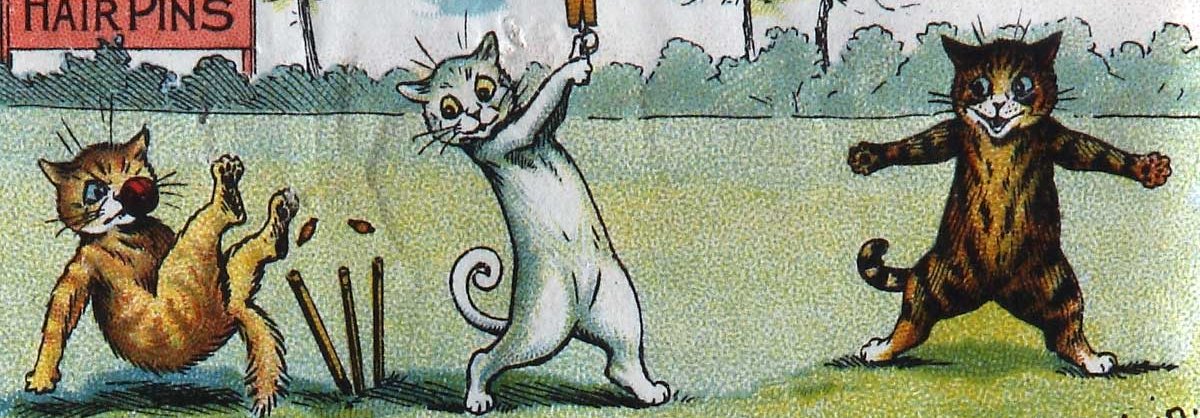Cat illustrations
Louis Wain was born in London in 1860 and attended the West London School of Art. He started out his career drawing animals and country scenes for publications such as The Illustrated Sporting and Dramatic News.
He took a particular interest in drawing cats and presented them with great warmth and character, in a way that had seldom been done before. He began selling his illustrations to The Illustrated London News. His first piece was published in 1884 and was called ‘Our cats: A domestic history’.
In 1886, Louis Wain was commissioned to illustrate a children’s book by Caroline Hughes (under the pen name Kari) titled ‘Madame Tabby’s Establishment’. In the same year, he published another illustration titled ‘A Kitten’s Christmas Party’, showing kittens engaged in various human activities including making speeches and playing games.
Wain’s cats became more and more human-like and expressive as his career progressed. His cute and comical drawings became wildly popular and for the first time the cat began to be seen as a lovable indoor pet, rather than just a rat-catcher.
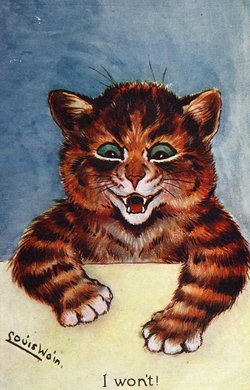
'I won't!' by Louis Wain, 1910 . Catalogue reference: COPY 1/226A
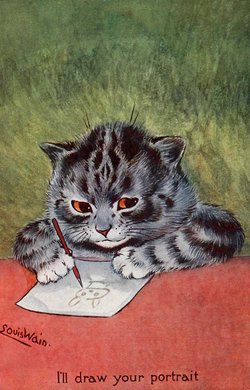
'I'll draw your portrait' by Louis Wain, 1910. Catalogue reference: COPY 1/226A
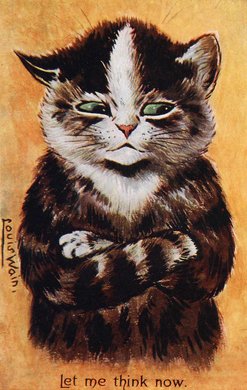
'Let me think now' by Louis Wain, 1910. Catalogue reference: COPY 1/226A.
-
- Title
- Copyright Office entry forms: Paintings and drawings
- Date
- Around 1905
Energy and creativity
Wain worked at an incredible rate, producing drawings for magazines, newspapers, children’s books and picture postcards, as well as his own ‘Louis Wain Annual’, which ran from 1901 to 1915. He also produced artwork to be used for advertising purposes for commercial companies.
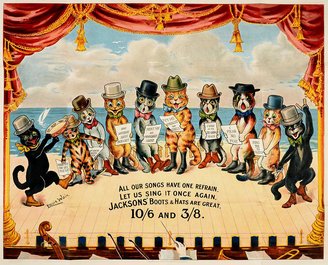
'Jackson's Boots and Hats' by Louis Wain, 1909. Catalogue reference: COPY 1/280.
-
- Title
- Copyright Office entry forms: Commercial paintings and drawings
- Date
- 1909
As a commercial artist, Wain submitted some of his illustrations to the Stationers’ Company for copyright protection and so these examples can still be found among our records in the COPY 1 record series.
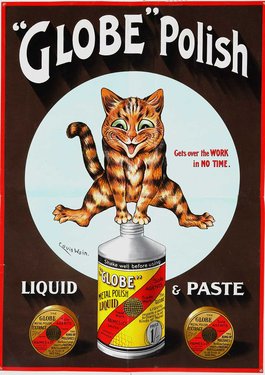
'Globe Polish' by Louis Wain, 1910. Catalogue reference: COPY 1/299.
-
- Title
- Copyright Office entry forms: Commercial paintings and drawings
- Date
- 1910
Personal tragedy
Louis Wain’s love of cats was inspired by personal tragedy. His wife, Emily Richardson, had become ill soon after their marriage in 1883 and Louis began drawing their cat, Peter, to help to cheer her up. These drawings brought Emily great happiness and she encouraged her husband to publish them. Sadly she died before she could celebrate the great successes of his career, in January 1887.
Wain later said of Peter, who had been a stray, ‘to him, properly, belongs the foundation of my career, the developments of my initial efforts, and the establishing of my work.’
Sadly, despite his productivity, Wain made errors of judgement when it came to protecting his how own financial interests. He often sold his drawings outright, allowing them to be reproduced without earning a penny. Despite the continued popularity of his work, he struggled to make ends meet while supporting his unmarried sisters and eventually descended into poverty.
Mental health problems
Sadly, Wain suffered with mental health problems throughout his life and these worsened after the death of his wife. It is now thought that he may have been suffering from schizophrenia as well as anxiety and depression.
Louis Wain’s drawings became more abstract and stylised later in his career, and some say this is evidence of his mental health problems. However, others argue that his stylistic drawings may have just been the result of experimentation, and we should not view Wain’s personality and mental health problems in such a simplistic way.
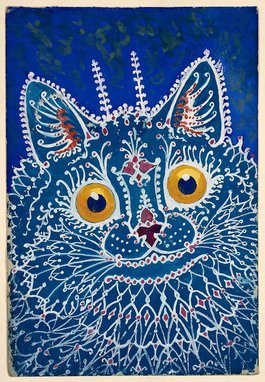
A cat in "gothic" style. Gouache by Louis Wain, 1925/1939. Wellcome Collection. Public Domain Mark.
With his mental health worsening, his sisters eventually committed him to the pauper ward of Springfield Mental Hospital in Tooting, south London in 1924.
His return in the 1921 census shows him living with three of his sisters in Willesden, Middlesex. His occupation is listed as ’artist’. A nurse from the ’Neurological hospital, Tooting’ happened to be visiting the family when the census was taken, three years before Louis was eventually committed there.
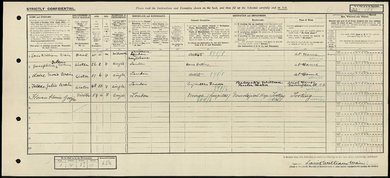
Louis Wain’s record in the 1921 census. Catalogue reference: RG 15/6471.
The Louis Wain Fund
In 1925 Louis Wain was discovered to be living in the pauper ward and a campaign was started to raise funds for his care. An outpouring of support followed, including from H G Wells and Prime Minister Stanley Baldwin, and the campaign was widely reported in press.
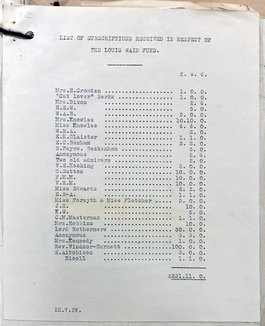
Transcript
List of subscriptions received in respect of the Louis Wain Fund
Mrs. E. Crowden £1 0s 0d
“Cat lover” Berks £1 0s 0d
Mrs. Dixon 2s 6d 0d
E.E.W 5s 0d
W.A.B. £5 0s 0d
Mrs. Knowles £10 10s 0d
Miss Knowles £6 6s 0d
W.R.A 2s 0d
E. H. Glaister £1 1s 0d
E. C. Benham £2 2s 0d
B. Fayre. Beckenham 5s 0d
Anonymous 2s 6d
Two old admirers 2s 0d
V. E. Hosking £5 0s 0d
G. Sutton £10 0s 0d
F. M. M. £10 0s 0d
Miss Edwards £2 2s 0d
E. B-A £1 1s 0d
Miss Forsyth & Miss Fletcher £5 0s 0d
J. R. 10s 0d
K. W. 5s 0d
C. M. Masterman £1 1s 0d
Mrs. Robbins 10s 0d
Lord Rothermere £50 0s 0d
Anonymous £3 3s 0d
Mrs. Kennedy £1 0s 0d
Rev Windsor-Garnett £100 0s 0d
E. Aitchison £3 0s 0d
Nicoll £1 1s 0d
£231.11.0.
List of subscriptions received in respect of the Louis Wain Fund
Mrs. E. Crowden £1 0s 0d
“Cat lover” Berks £1 0s 0d
Mrs. Dixon 2s 6d 0d
E.E.W 5s 0d
W.A.B. £5 0s 0d
Mrs. Knowles £10 10s 0d
Miss Knowles £6 6s 0d
W.R.A 2s 0d
E. H. Glaister £1 1s 0d
E. C. Benham £2 2s 0d
B. Fayre. Beckenham 5s 0d
Anonymous 2s 6d
Two old admirers 2s 0d
V. E. Hosking £5 0s 0d
G. Sutton £10 0s 0d
F. M. M. £10 0s 0d
Miss Edwards £2 2s 0d
E. B-A £1 1s 0d
Miss Forsyth & Miss Fletcher £5 0s 0d
J. R. 10s 0d
K. W. 5s 0d
C. M. Masterman £1 1s 0d
Mrs. Robbins 10s 0d
Lord Rothermere £50 0s 0d
Anonymous £3 3s 0d
Mrs. Kennedy £1 0s 0d
Rev Windsor-Garnett £100 0s 0d
E. Aitchison £3 0s 0d
Nicoll £1 1s 0d
£231.11.0.
A list of subscriptions to the Louis Wain fund. Catalogue reference: PRO 30/69/1491
-
- Title
- Correspondence and papers of the Louis Wain Fund
- Date
- 1929
The campaign succeeded, raising sufficient funds to move Wain to the Bethlem Royal Hospital, and then in 1930 to Napsbury Hospital near St Albans in Hertfordshire, providing him with more comfortable surroundings, and also supporting his elderly sisters.
